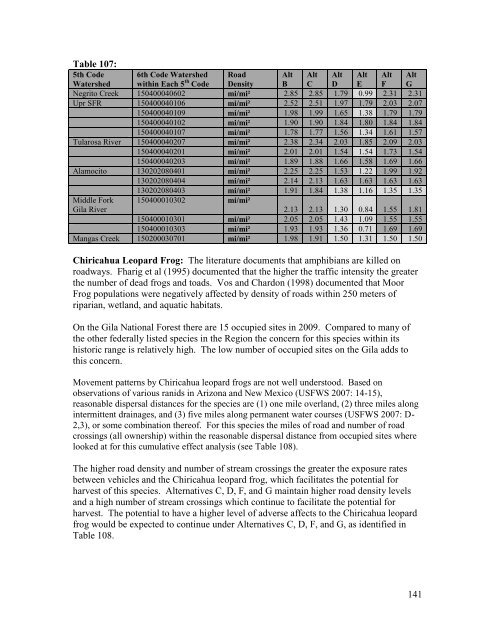Wildlife Specialist report
Wildlife Specialist report
Wildlife Specialist report
Create successful ePaper yourself
Turn your PDF publications into a flip-book with our unique Google optimized e-Paper software.
Table 107:<br />
5th Code<br />
6th Code Watershed<br />
Watershed within Each 5 th Road Alt Alt Alt Alt Alt Alt<br />
Code Density B C D E F G<br />
Negrito Creek 150400040602 mi/mi² 2.85 2.85 1.79 0.99 2.31 2.31<br />
Upr SFR 150400040106 mi/mi² 2.52 2.51 1.97 1.79 2.03 2.07<br />
150400040109 mi/mi² 1.98 1.99 1.65 1.38 1.79 1.79<br />
150400040102 mi/mi² 1.90 1.90 1.84 1.80 1.84 1.84<br />
150400040107 mi/mi² 1.78 1.77 1.56 1.34 1.61 1.57<br />
Tularosa River 150400040207 mi/mi² 2.38 2.34 2.03 1.85 2.09 2.03<br />
150400040201 mi/mi² 2.01 2.01 1.54 1.54 1.73 1.54<br />
150400040203 mi/mi² 1.89 1.88 1.66 1.58 1.69 1.66<br />
Alamocito 130202080401 mi/mi² 2.25 2.25 1.53 1.22 1.99 1.92<br />
130202080404 mi/mi² 2.14 2.13 1.63 1.63 1.63 1.63<br />
130202080403 mi/mi² 1.91 1.84 1.38 1.16 1.35 1.35<br />
Middle Fork 150400010302 mi/mi²<br />
Gila River<br />
2.13 2.13 1.30 0.84 1.55 1.81<br />
150400010301 mi/mi² 2.05 2.05 1.43 1.09 1.55 1.55<br />
150400010303 mi/mi² 1.93 1.93 1.36 0.71 1.69 1.69<br />
Mangas Creek 150200030701 mi/mi² 1.98 1.91 1.50 1.31 1.50 1.50<br />
Chiricahua Leopard Frog: The literature documents that amphibians are killed on<br />
roadways. Fharig et al (1995) documented that the higher the traffic intensity the greater<br />
the number of dead frogs and toads. Vos and Chardon (1998) documented that Moor<br />
Frog populations were negatively affected by density of roads within 250 meters of<br />
riparian, wetland, and aquatic habitats.<br />
On the Gila National Forest there are 15 occupied sites in 2009. Compared to many of<br />
the other federally listed species in the Region the concern for this species within its<br />
historic range is relatively high. The low number of occupied sites on the Gila adds to<br />
this concern.<br />
Movement patterns by Chiricahua leopard frogs are not well understood. Based on<br />
observations of various ranids in Arizona and New Mexico (USFWS 2007: 14-15),<br />
reasonable dispersal distances for the species are (1) one mile overland, (2) three miles along<br />
intermittent drainages, and (3) five miles along permanent water courses (USFWS 2007: D-<br />
2,3), or some combination thereof. For this species the miles of road and number of road<br />
crossings (all ownership) within the reasonable dispersal distance from occupied sites where<br />
looked at for this cumulative effect analysis (see Table 108).<br />
The higher road density and number of stream crossings the greater the exposure rates<br />
between vehicles and the Chiricahua leopard frog, which facilitates the potential for<br />
harvest of this species. Alternatives C, D, F, and G maintain higher road density levels<br />
and a high number of stream crossings which continue to facilitate the potential for<br />
harvest. The potential to have a higher level of adverse affects to the Chiricahua leopard<br />
frog would be expected to continue under Alternatives C, D, F, and G, as identified in<br />
Table 108.<br />
141
















